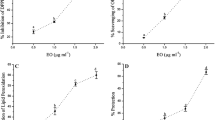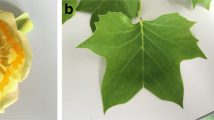Abstract
Objective
To study the chemical composition, anticancer, anti-neuroinflflammatory, and antioxidant activities of the essential oil of Patrinia scabiosaefolia (EO-PS).
Methods
Patrinia scabiosaefolia was analyzed by gas chromatography-mass spectrometry. Eight human carcinoma cell lines, including SGC-7901, AGS, HepG2, HT-29, HCT-8, 5-FU/HCT-8, HeLa, and MDA-MB-231, were assessed by methylthiazolyldiphenyltetrazolium bromide (MTT) assay. Anti-neuroinflflammatory activity was assessed by production of interleukin (IL)-1β and IL-6 induced by lipopolysaccharide in BV-2 cells (microglia from mice). The antioxidant activity was evaluated with a 2,2-diphenyl-1-picrylhydrazyl (DPPH) scavenging assay.
Results
Forty-four components, representing 83.919% of the total oil, were identifified in the EO-PS. The major constituents were caryophyllene oxide (12.802%), caryophyllene (6.909%), α-caryophyllene (2.927%), β-damascenone (3.435%), calarene (5.621%), and phenol (3.044%). The MTT assay showed that the EO-PS exhibited significant dose-dependent growth inhibition in the 50–200 μg/mL dilution range. The EO-PS exhibited a dose-dependent scavenging activity against the DPPH radical, with an half of maximal inhibitory concentration 1.455 mg/mL.
Conclusions
The EO-PS possesses a wide range of antitumor, anti-neuroinflflammatory and antioxidant activities, suggesting that it may be a good candidate for further investigations of new bioactive substances.
Similar content being viewed by others
References
Luo H, Cui Y, Shen Y, Lou Z. Clinical observation and pharmacological investigation of the sedative and hypnotic effects of the Chinese drug rhizome and root of Patrinia scabiosaefolia Fisch. J Tradit Chin Med 1986;6:89–94.
Zhang T, Li Q, Li K, Li Y, Li J, Wang G, et al. Antitumor effects of saponin extract from Patrinia villosa (Thunb.) Juss on mice bearing U14 cervical cancer. Phytother Res 2008;22:640–645.
Xie Y, Peng J, Fan G, Wu Y. Chemical composition and antioxidant activity of volatiles from Patrinia Villosa Juss obtained by optimized supercritical fluid extraction. J Pharm Biomed Anal 2008;48:796–801.
Chiu LC, Ho TS, Wong EY, Ooi VE. Ethyl acetate extract of Patrinia scabiosaefolia downregulates anti-apoptotic Bcl-2/Bcl-X(L) expression, and induces apoptosis in human breast carcinoma MCF-7 cells independent of caspase-9 activation. J Ethnopharmacol 2006;105:263–268.
Gao L, Zhang L, Li N, Liu J, Cai P, Yang S. New triterpenoid saponins from Patrinia scabiosaefolia. Carbohydr Res 2011;346:2881–2885.
Liu L, Shen A, Chen Y, Wei L, Lin J, Thomas J, et al. Patrinia scabiosaefolia induces mitochondrial-dependent apoptosis in a mouse model of colorectal cancer. Oncol Rep 2013;30:897–903.
Peng J, Chen Y, Lin J, Zhuang Q, Xu W, Hong Z, et al. Patrinia scabiosaefolia extract suppresses proliferation and promotes apoptosis by inhibiting the STAT3 pathway in human multiple myeloma cells. Mol Med Rep 2011;4:313–318.
Cho EJ, Shin JS, Noh YS, Cho YW, Hong SJ, Park JH, et al. Anti-inflammatory effects of methanol extract of Patrinia scabiosaefolia in mice with ulcerative colitis. J Ethnopharmacol 2011;136:428–435.
Al-Kalaldeh JZ, Abu-Dahab R, AfifiFU. Volatile oil composition and antiproliferative activity of Laurus nobilis, Origanum syriacum, Origanum vulgare, and Salvia triloba against human breast adenocarcinoma cells. Nutr Res 2010;30:271–278.
Victoria FN, Lenardão EJ, Savegnago L, Perin G, Jacob RG, Alves D, et al. Essential oil of the leaves of Eugenia uniflora L.: Antioxidant and antimicrobial properties. Food Chem Toxicol 2012;50:2668–2674.
Kamazeri TS, Samah OA, Taher M, Susanti D, Qaralleh H. Antimicrobial activity and essential oils of Curcuma aeruginosa, Curcuma mangga, and Zingiber cassumunar from Malaysia. Asian Pac J Trop Med 2012;5:202–209.
Emiroğlu ZK, Yemiş GP, Coşkun BK, Candoğan K. Antimicrobial activity of soy edible films incorporated with thyme and oregano essential oils on fresh ground beef patties. Meat Sci 2010;86:283–288.
Kim J, Park EJ. Cytotoxic anticancer candidates from natural resources. Curr Med Chem Anticancer Agents 2002;2:485–537.
Afoulous S, Ferhout H, Raoelison EG, Valentin A, Moukarzel B, Couderc F, et al. Chemical composition and anticancer, antiinflammatory, antioxidant and antimalarial activities of leaves essential oil of Cedrelopsis grevei. Food Chem Toxicol 2013;56:352–362.
Russo A, Formisano C, Rigano D, Senatore F, Delfine S, Cardile V, et al. Chemical composition and anticancer activity of essential oils of Mediterranean sage (Salvia officinalis L.) grown in different environmental conditions. Food Chem Toxicol 2013;55:42–47.
Esakkirajan M, Prabhu NM, Manikandan R, Beulaja M, Prabhu D, Govindaraju K, et al. Apoptosis mediated antiproliferative effect of compound isolated from Cassia auriculata leaves against human colon cancer cell line. Spectrochim Acta A 2014;127:484–489.
Sharma PR, Mondhe DM, Muthiah S, Pal HC, Shahi AK, Saxena AK, et al. Anticancer activity of an essential oil from Cymbopogon flexuosus. Chem Biol Interact 2009;179:160–168.
Pinheiro BG, Silva AS, Souza GE, Figueiredo JG, Cunha FQ, Lahlou S, et al. Chemical composition, antinociceptive and anti-inflammatory effects in rodents of the essential oil of Peperomia serpens (Sw.) Loud. J Ethnopharmacol 2011;138:479–486.
Kim KN, Ko YJ, Yang HM, Ham YM, Roh SW, et al. Antiinflammatory effect of essential oil and its constituents from fingered citron (Citrus medica L. var. sarcodactylis) through blocking JNK, ERK and NF-κB signaling pathways in LPS-activated RAW 264.7 cells. Food Chem Toxicol 2013;57:126–131.
Lindgren M, Rosenthal-Aizman K, Saar K, Eiríksdóttir E, Jiang Y, Sassian M, et al. Overcoming methotrexate resistance in breast cancer tumour cells by the use of a new cell-penetrating peptide. Biochem Pharmacol 2006;71:416–425.
Zhao J, Jiang P, Zhang W. Molecular networks for the study of TCM pharmacology. Brief Bioinf (Chin) 2010;11:417–430.
Ghelardini C, Galeotti N, Di Cesare Mannelli L, Mazzanti G, Bartolini A. Local anaesthetic activity of beta-caryophyllene. Farmaco 2001;56:387–389.
Chavan MJ, Wakte PS, Shinde DB. Analgesic and antiinflammatory activity of caryophyllene oxide from Annona squamosa L. bark. Phytomedicine 2010;17:149–151.
Monzote L, Stamberg W, Staniek K, Gille L. Toxic effects of carvacrol, caryophyllene oxide, and ascaridole from essential oil of Chenopodium ambrosioides on mitochondria. Toxicol Appl Pharm 2009;240:337–347.
Xiao J, Chen X, Zhang Y, Jiang X, Xu M. Cytotoxicity of Marchantia convoluta leaf extracts to human liver and lung cancer cells. Braz J Med Biol Res 2006;39:731–738.
Zahin M, Aqil F, Husain FM, Ahmad I. Antioxidant capacity and antimutagenic potential of Murraya koenigii. Biomed Res Int 2013;2013:1–10.
Author information
Authors and Affiliations
Corresponding author
Additional information
Supported by the National Natural Science Foundation of China (No. 81403390), the Provincial Natural Science Foundation of Fujian (No. 2014J01352 and No. 2014J01360), Provincial Health Department Foundation of Fujian (No. 2013-2-55), Fujian University of Traditional Chinese Medicine Key Discipline Construction Foundation (Nos. X2012012, X2013014, X2013015, X2014132 and X2015020)
Rights and permissions
About this article
Cite this article
Lin, J., Cai, Qy., Xu, W. et al. Chemical Composition, Anticancer, Anti-neuroinflammatory, and Antioxidant Activities of the Essential Oil of Patrinia scabiosaefolia. Chin. J. Integr. Med. 24, 207–212 (2018). https://doi.org/10.1007/s11655-016-2459-4
Received:
Published:
Issue Date:
DOI: https://doi.org/10.1007/s11655-016-2459-4




